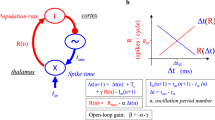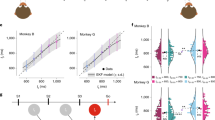Abstract
A critical step in self-motion perception and spatial awareness is the integration of motion cues from multiple sensory organs that individually do not provide an accurate representation of the physical world. One of the best-studied sensory ambiguities is found in visual processing, and arises because of the inherent uncertainty in detecting the motion direction of an untextured contour moving within a small aperture1,2,3,4. A similar sensory ambiguity arises in identifying the actual motion associated with linear accelerations sensed by the otolith organs in the inner ear5,6. These internal linear accelerometers respond identically during translational motion (for example, running forward) and gravitational accelerations experienced as we reorient the head relative to gravity (that is, head tilt). Using new stimulus combinations, we identify here cerebellar and brainstem motion-sensitive neurons that compute a solution to the inertial motion detection problem. We show that the firing rates of these populations of neurons reflect the computations necessary to construct an internal model representation of the physical equations of motion.
This is a preview of subscription content, access via your institution
Access options
Subscribe to this journal
Receive 51 print issues and online access
$199.00 per year
only $3.90 per issue
Buy this article
- Purchase on Springer Link
- Instant access to full article PDF
Prices may be subject to local taxes which are calculated during checkout




Similar content being viewed by others
References
Shimojo, S., Silverman, G. H. & Nakayama, K. Occlusion and the solution to the aperture problem for motion. Vision Res. 29, 619–626 (1989)
Adelson, E. H. & Movshon, J. A. Phenomenal coherence of moving visual patterns. Nature 300, 523–525 (1982)
Movshon, J. A., Adelson, E. H., Gizzi, M. S. & Newsome, W. T. in Pattern Recognition Mechanisms: Pontificiae Academiae Scientiarum Scripta Varia (eds Chagas, C., Gattass, R. & Gross, C.) Vol. 54, 117–151 (Vatican, Rome, 1985)
Pack, C. C. & Born, R. T. Temporal dynamics of a neural solution to the aperture problem in visual area MT of macaque brain. Nature 409, 1040–1042 (2001)
Fernández, C. & Goldberg, J. M. Physiology of peripheral neurons innervating otolith organs of the squirrel monkey. I. Response to static tilts and to long-duration centrifugal force. J. Neurophysiol. 39, 970–984 (1976)
Angelaki, D. E. & Dickman, J. D. Spatiotemporal processing of linear acceleration: primary afferent and central vestibular neuron responses. J. Neurophysiol. 84, 2113–2132 (2000)
Einstein, A. Uber das Relativitätsprinzip und die aus demselben gezogenen Folgerungen. Jber. Radioakt. 4, 411–462 (1908)
Angelaki, D. E., McHenry, M. Q., Dickman, J. D., Newlands, S. D. & Hess, B. J. M. Computation of inertial motion: neural strategies to resolve ambiguous otolith information. J. Neurosci. 19, 316–327 (1999)
Merfeld, D. M., Zupan, L. H. & Peterka, R. J. Humans use internal models to estimate gravity and linear acceleration. Nature 398, 615–618 (1999)
Merfeld, D. M. & Zupan, L. H. Neural processing of gravitoinertial cues in humans. III. Modeling tilt and translation responses. J. Neurophysiol. 87, 819–833 (2002)
Zupan, L. H., Peterka, R. J. & Merfeld, D. M. Neural processing of gravito-inertial cues in humans. I. Influence of the semicircular canals following post-rotatory tilt. J. Neurophysiol. 84, 2001–2015 (2000)
Green, A. M. & Angelaki, D. E. Resolution of sensory ambiguities for gaze stabilization requires a second neural integrator. J. Neurosci. 23, 9265–9275 (2003)
Green, A. M. & Angelaki, D. E. An integrative neural network for detecting inertial motion and head orientation. J. Neurophysiol. Advance online publication, 31 March 2004 (doi: 10.1152/jn.01234.2003)
Goldstein, H. Classical Mechanics (Addison–Wesley, Reading, Massachusetts, 1980)
Carleton, S. C. & Carpenter, M. B. Distribution of primary vestibular fibers in the brainstem and cerebellum of the monkey. Brain Res. 294, 281–298 (1984)
Newlands, S. D. et al. Central projections of the saccular and utricular nerves in macaques. J. Comp. Neurol. 466, 31–47 (2003)
Kotchabhakdi, N. & Walberg, F. Primary vestibular afferent projections to the cerebellum as demonstrated by retrograde axonal transport of horseradish peroxidase. Brain Res. 142, 142–146 (1978)
Angaut, P. & Bowsher, D. Ascending projections of the medial cerebellar (fastigial) nucleus: an experimental study in the cat. Brain Res. 24, 49–68 (1970)
Asamura, C., Thach, W. T. & Jones, E. G. Distribution of cerebellar terminations and their relation to other afferent terminations in the ventral lateral thalamic region of the monkey. Brain Res. Rev. 5, 237–265 (1983)
Batton, R. R., Jayaraman, A., Ruggiero, D. & Carpenter, M. B. Fastigial efferent projections in the monkey: an autoradiographic study. J. Comp. Neurol. 174, 281–305 (1977)
Kalil, K. Projections of the cerebellar and dorsal column nuclei upon the thalamus of the rhesus monkey. J. Comp. Neurol. 195, 25–50 (1981)
Lang, W., Buttner-Ennever, J. A. & Buttner, U. Vestibular projections to the monkey thalamus: An autoradiographic study. Brain Res. 177, 3–17 (1979)
Newlands, S. D., Shaikh, A. G., Green, A. M., Dickman, J. D., Angelaki, D. E. Semicircular canal inactivation abolishes tilt-translation discrimination property of fastigial and vestibular nuclei neurons. (Abstract viewer/itinerary planner, Society for Neuroscience, Washington DC, 2004)
Goldberg, J. M. & Fernandez, C. Physiology of peripheral neurons innervating semicircular canals of the squirrel monkey. II. Response to sinusoidal stimulation and dynamics of peripheral vestibular system. J. Neurophysiol. 34, 661–675 (1971)
Dickman, J. D. & Angelaki, D. E. Vestibular convergence patterns in vestibular nuclei neurons of alert primates. J. Neurophysiol. 88, 3518–3533 (2002)
Gribble, P. L. & Scott, S. H. Overlap of internal models in motor cortex for mechanical loads during reaching. Nature 417, 938–941 (2002)
Kawato, M. Internal models for control and trajectory planning. Curr. Opin. Neurobiol. 6, 718–727 (1999)
Padoa-Schioppa, C., Li, C.-S. R. & Bizzi, E. Neuronal correlates of kinematics-to-dynamics transformation in the supplementary motor area. Neuron 36, 751–765 (2002)
Angelaki, D. E. & Dickman, J. D. Premotor neurons encode torsional eye velocity during smooth-pursuit eye movements. J. Neurosci. 23, 2971–2979 (2003)
Draper, N. R. & Smith, H. Applied Regression Analysis (J. Wiley, Sons, Inc., New York, 1998)
Acknowledgements
The work was supported by grants from NIH and NASA. We thank E. Klier, C. Fetsch, G. DeAngelis and L. Snyder for aid in preparation of the manuscript.
Author information
Authors and Affiliations
Corresponding author
Ethics declarations
Competing interests
The authors declare that they have no competing financial interests.
Supplementary information
Supplementary Information
This file contains two supplemental figures that provide further theoretical and experimental details. Supplemental Fig. 1 shows a schematic representation of the computations to estimate translational acceleration for the motion stimuli used in the manuscript. Supplemental Fig. 2 shows additional data about the phase distribution of the populations of neurons. (DOC 188 kb)
Rights and permissions
About this article
Cite this article
Angelaki, D., Shaikh, A., Green, A. et al. Neurons compute internal models of the physical laws of motion. Nature 430, 560–564 (2004). https://doi.org/10.1038/nature02754
Received:
Accepted:
Issue Date:
DOI: https://doi.org/10.1038/nature02754
This article is cited by
-
Vestibular contributions to linear motion perception
Experimental Brain Research (2024)
-
Disturbance Rejection in the Cerebellum
SN Computer Science (2024)
-
Effects of motion paradigm on human perception of tilt and translation
Scientific Reports (2022)
-
Subthalamic deep brain stimulation affects heading perception in Parkinson’s disease
Journal of Neurology (2022)
-
Individual motion perception parameters and motion sickness frequency sensitivity in fore-aft motion
Experimental Brain Research (2021)
Comments
By submitting a comment you agree to abide by our Terms and Community Guidelines. If you find something abusive or that does not comply with our terms or guidelines please flag it as inappropriate.



